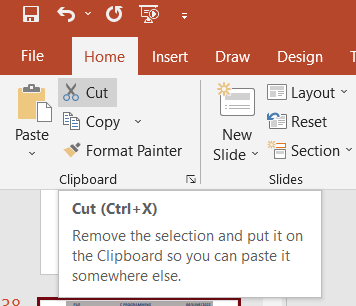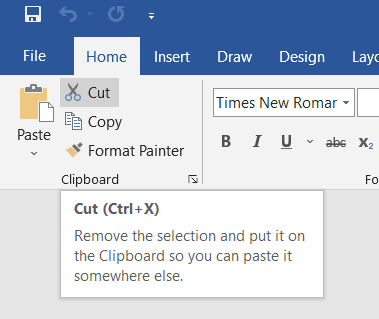What does Ctrl + X do?
Ctrl+X is a keyboard shortcut to cut selected text or content in a document or file. When you press Ctrl+X, the selected text or content is removed from its current location and copied to the clipboard, which can be pasted elsewhere using the Ctrl+V shortcut. In summary, Ctrl+X is a cut command commonly used for editing text, but it can also be used for missing files and folders in file managers.

How to use the Ctrl+X keyboard shortcut?
To use the Ctrl+X keyboard shortcut to cut selected text or content, follow these steps:
- Select the text or content you want to cut. This can be done by clicking and dragging the cursor over the text or content you want to cut. Alternatively, you can select the text or content from the Shift key and the arrow keys.
- Once the text or content is selected, press the Ctrl+X shortcut on your keyboard. This will cut the selected text or content from its current location and copy it to the clipboard.
- Navigate wherein you want to paste the cut text or content. This can be a different location in the same document or file or a different one.
- Press the Ctrl+V shortcut on your keyboard to paste the cut text or content from the clipboard into the new location.
That's it! Using the Ctrl+X keyboard shortcut to cut and paste text or content, you can quickly and easily move or duplicate content in your documents and files.
Ctrl+X in an Internet browser:
The Ctrl+X keyboard shortcut typically does not cut text or content in an internet browser. Instead, it performs a different function depending on the browser you are using:
- Google Chrome: The Ctrl+X shortcut does not have a specific function by default. However, some websites or web applications may use it for specific purposes.
- Mozilla Firefox: The Ctrl+X shortcut does not have a specific function by default in Firefox. Again, some websites or web applications may use it for particular purposes.
- Microsoft Edge: In Edge, the Ctrl+X shortcut is used to cut selected text or content, just like in other applications. This can be useful for copying and pasting text between websites or applications.
- Safari: In Safari on Mac, the Ctrl+X shortcut is not used for cutting text or content. Instead, it performs the same function as the Command+X shortcut: cut selected text or content.
It's important to note that some websites or web applications may have custom keyboard shortcuts overriding the default browser shortcuts so that the Ctrl+X shortcut may behave differently depending on your site or application.
Ctrl+X in Excel and other spreadsheet programs:
In Excel and other spreadsheet programs, the Ctrl+X keyboard shortcut is used to cut selected cells or ranges, similar to how it works in other applications. Here's how to use it:
- Select the cells or range of cells that you want to cut.
- Press the Ctrl+X shortcut on your keyboard. The selected cells or range will be removed from their current location and copied to the clipboard.
- Navigate wherein you want to paste the cut cells or range.
- Press the Ctrl+V shortcut on your keyboard to paste the cut cells or range from the clipboard into the new location.
In Excel and other spreadsheet programs, the Ctrl+X shortcut is a powerful tool for quickly rearranging data and moving cells between different parts of your worksheet. It can also be useful for deleting cells or ranges without losing their data.
Ctrl+X in Microsoft PowerPoint:
In Microsoft PowerPoint, the Ctrl+X keyboard shortcut is used to cut selected slides, shapes, or text boxes from the presentation. Here's how to use it:
- Select the slide, shape, or text box you want to cut.
- Press the Ctrl+X shortcut on your keyboard. The selected item(s) will be removed from the current location and copied to the clipboard.
- Navigate where you want to paste the cut item(s).
- Press the Ctrl+V shortcut on your keyboard to paste the cut item(s) from the clipboard into the new location.
In PowerPoint, the Ctrl+X shortcut is useful for rearranging and reordering slides and other content within your presentation. It can also be used to delete slides or other content without losing the data they contain.

Ctrl+X in the command line:
In the command line interface (CLI), the Ctrl+X keyboard shortcut typically does not perform a cut operation as it does in graphical user interfaces. Instead, it depends on the context of your command line interface. Here are some common uses of the Ctrl+X shortcut in various CLI environments:
- Bash: In Bash, the Ctrl+X shortcut terminates the current command line prompt, returning you to the previous level in the terminal. This is useful to cancel a command you've started typing.
- PowerShell: The Ctrl+X shortcut is not used by default in PowerShell.
- However, some PowerShell extensions or add-ons may use it for specific purposes.
- Navigate where you want to paste the cut cells or range.
- Windows Command Prompt: The Ctrl+X shortcut is not used by default in the Windows Command Prompt. However, some third-party utilities or extensions may use it for specific purposes.
Note: The Ctrl+X shortcut may behave differently depending on your specific CLI environment and any customizations or add-ons you have installed. It's always a good idea to consult the documentation for your particular CLI environment to understand the available keyboard shortcuts and their functions.
Ctrl+X in Word and other Word processors:
In Word and other Word processors, the Ctrl+X keyboard shortcut is used to cut selected text or content from a document. Here's how to use it:
- Select the text or content that you want to cut. This can be done by clicking and dragging the cursor over the reader or by using the Shift key in combination with the arrow keys to select the text.
- Once the text or content is selected, press the Ctrl+X shortcut on your keyboard. This will cut the selected text or content from its current location and copy it to the clipboard.
- Navigate wherein you want to stick the cut text or content. This can be a different location in the same document or file or a different one.
- Press the Ctrl+V shortcut on your keyboard to paste the cut text or content from the clipboard into the new location.
In Word and other word processors, the Ctrl+X shortcut is a powerful tool for quickly rearranging text and other content within your document. It can also be used to delete text or other content without losing the data it contains.

Ctrl+X in windows
In Windows, the Ctrl+X keyboard shortcut does not have a universal function across all applications and contexts. However, it is a commonly used shortcut in Windows Explorer, the default file manager for Windows. Here's how it works:
- Open Windows Explorer and navigate to the file or folder you want to paste.
- Select the file or folder by clicking on it once.
- Press the Ctrl+X shortcut on your keyboard. This will cut the selected file or folder from its current location and copy it to the clipboard.
- Navigate to wherein you need to stick the reduce report or folder.
- Press the Ctrl+V shortcut on your keyboard to paste the cut file or folder from the clipboard into the new location.
In Windows Explorer, the Ctrl+X shortcut is a useful tool for quickly moving files and folders between different locations on your computer. It can also be used to delete files or folders without losing their data. However, it's important to use caution when cutting and pasting files, as it can be easy to accidentally move or delete important files if you're not paying attention.